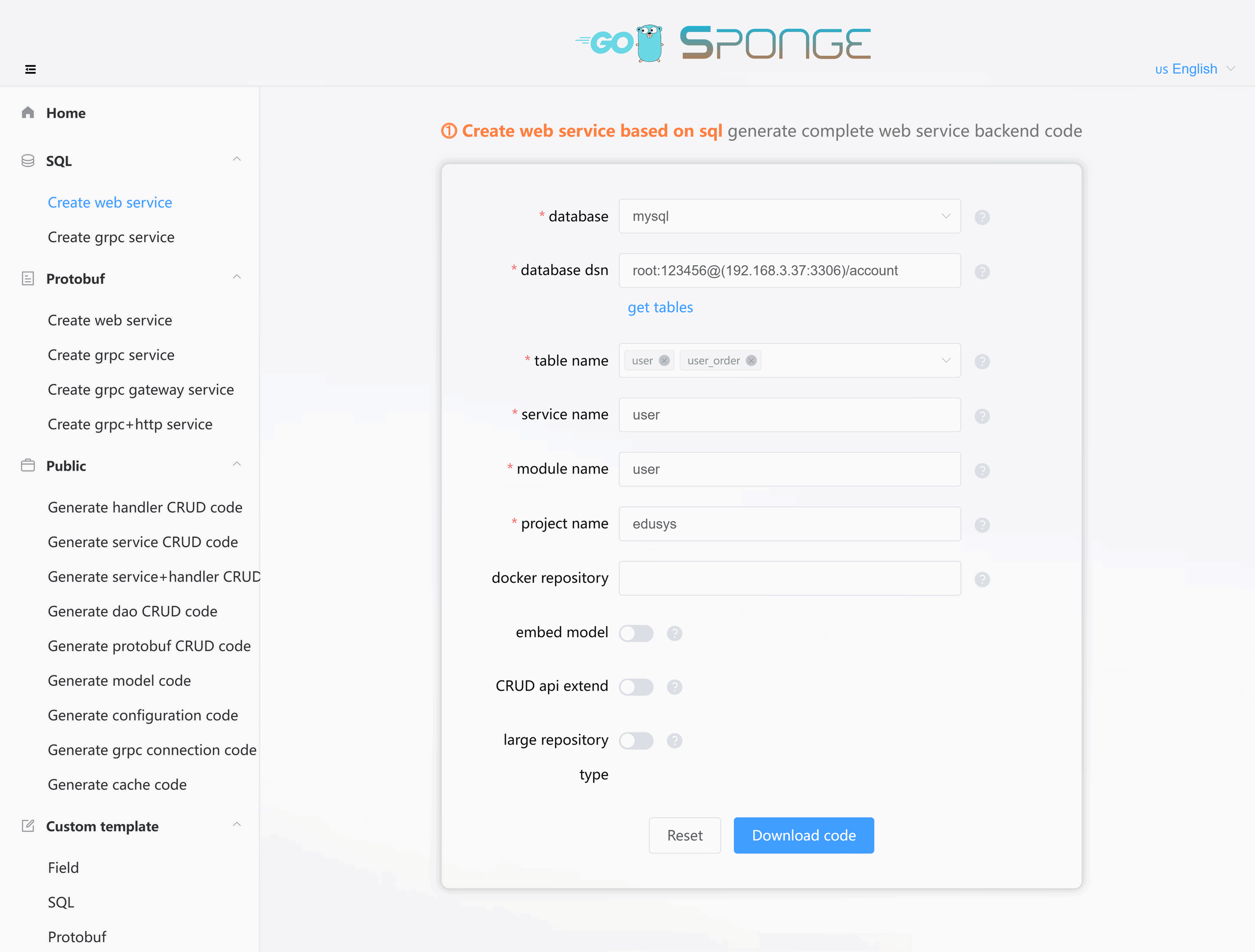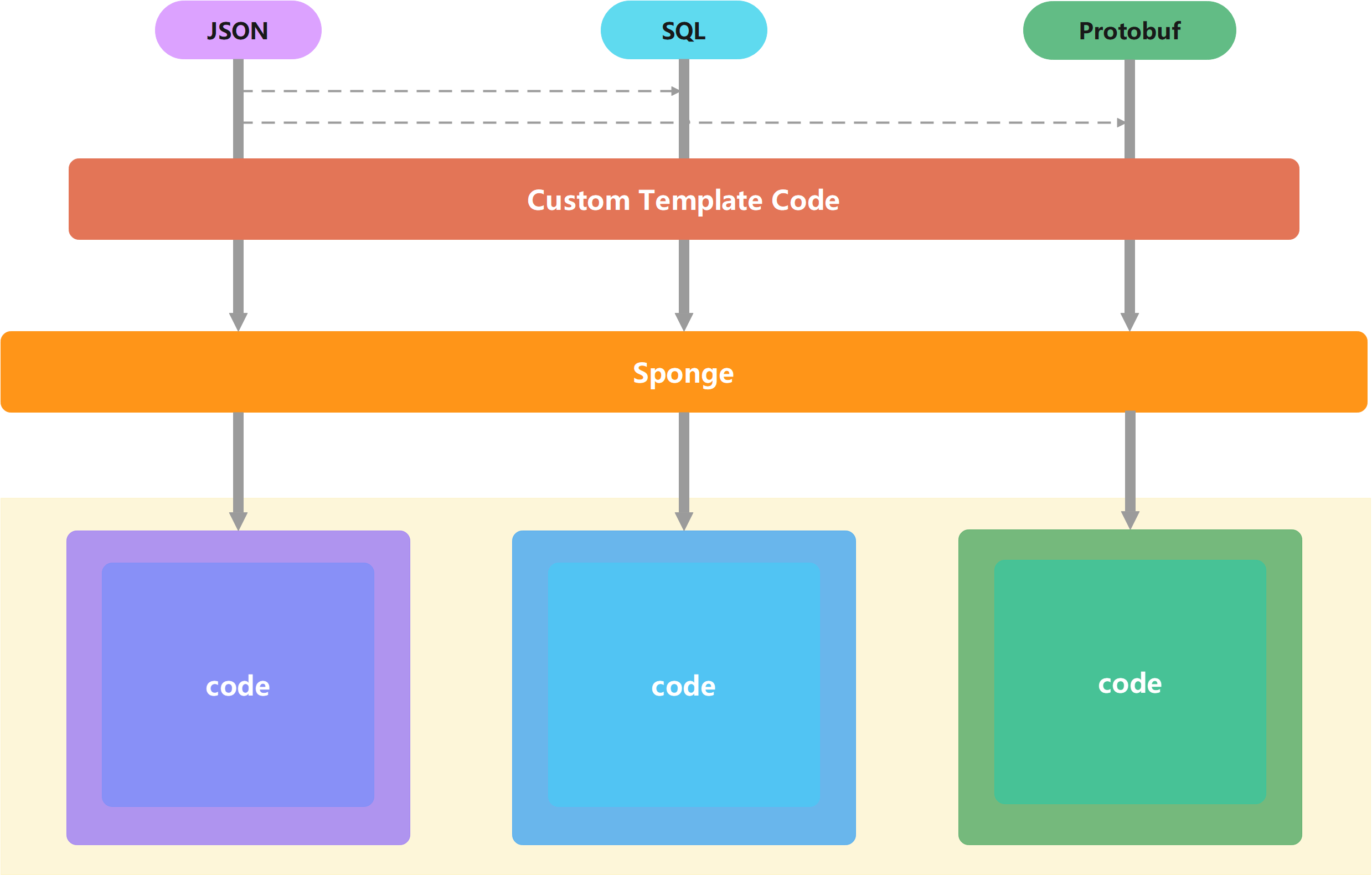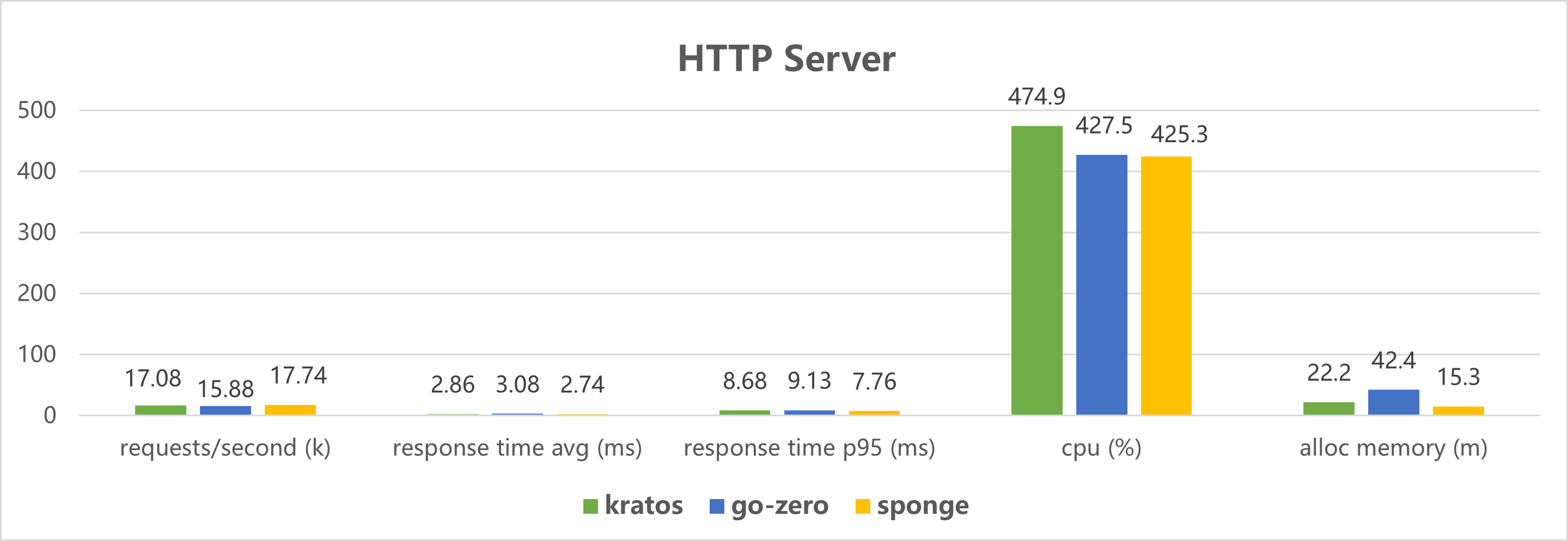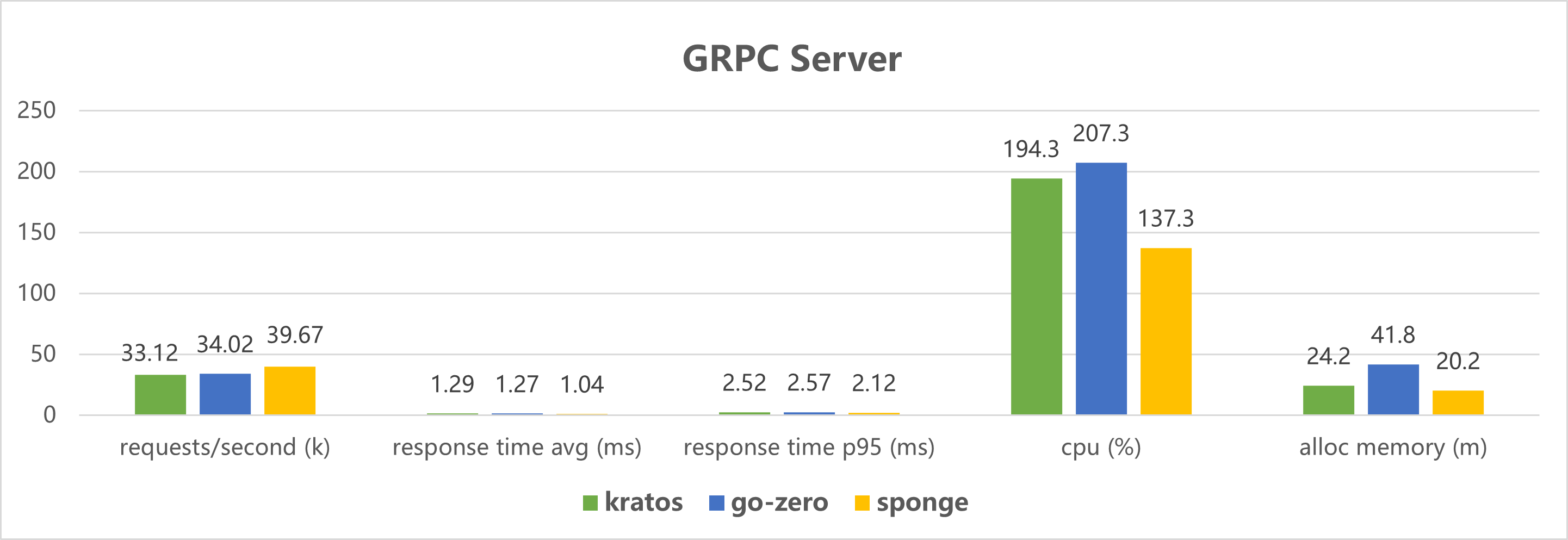|
|
||
|---|---|---|
| .github | ||
| api | ||
| assets | ||
| cmd | ||
| configs | ||
| deployments | ||
| docs | ||
| examples | ||
| internal | ||
| pkg | ||
| scripts | ||
| test | ||
| third_party | ||
| .gitignore | ||
| .golangci.yml | ||
| Jenkinsfile | ||
| LICENSE | ||
| Makefile | ||
| Makefile-for-http | ||
| README.md | ||
| codecov.yml | ||
| doc.go | ||
| go.mod | ||
| go.sum | ||
README.md
English | 简体中文

Sponge is a powerful and easy-to-use Go development framework. Its core philosophy is "Definition is Code", means generating modular Go code by parsing SQL, Protobuf, and JSON files. These code modules can be flexibly combined to build various types of complete backend services.
Sponge provides a one-stop project development solution that covers code generation, development, testing, API documentation, and deployment. It helps developers easily build stable, reliable, and high-performance backend services (including RESTful APIs, gRPC, HTTP+gRPC, gRPC Gateway, etc.) in a "low-code" approach, greatly improve the efficiency and quality of project development.
Applicable Scenarios
Sponge is ideal for rapidly building various types of high-performance backend services. Applicable scenarios include:
- Developing RESTful API services
- Building microservices projects
- Cloud-native development
- Refactoring old projects
- Serving as a starting point for Go beginners or teams to learn Go project structure and best practices
In addition, developers can generate business-specific code by customizing templates.
Key Features
-
One-click generation of complete backend service code
ForWeb,gRPCorHTTP+gRPCservices that only requireCRUD APIs, noGocode needs to be written. Simply connect to a database (e.g.,MySQL,MongoDB,PostgreSQL,SQLite) to one-click generate complete backend service code and easily deploy it to Linux servers, Docker, or Kubernetes. -
Efficient development of general-purpose services
When developing general-purposeWeb,gRPC,HTTP+gRPC, orgRPC Gatewayservices, you only need to focus on three aspects:- Defining database tables;
- Defining API descriptions in Protobuf files;
- In the generated templates, use built-in AI assistants or manually write business logic code.
The framework code and CRUD API code are all automatically generated by sponge.
-
Support for custom templates, offering flexible extensibility
Sponge supports generating various types of project-specific code using custom templates, not limited to theGolanguage. For examplebackend code,frontend code,test code,build and deployment scripts, etc. -
Generate code on the page, simple and easy to use
Sponge provides code generation on the page, avoiding complex command-line operations, simply filling in parameters on the page to generate code with one click. -
Sponge and AI Assistant Collaborative Development to Form a Closed-Loop Workflow
Sponge, combined with built-in AI assistants (DeepSeek, ChatGPT, Gemini), forms a complete and efficient development solution:- Sponge: Responsible for infrastructure code generation, including
service framework,CRUD API,custom API (lacking business logic), etc. - AI assistant: Focuses on business logic implementation, including
table structure DDL design,custom API design,business logic, etc.
- Sponge: Responsible for infrastructure code generation, including
Getting Started
-
Install sponge
Sponge supports installation on Windows, macOS, Linux and Docker. Click to view the sponge installation guide.
-
Open the code generation UI
After installation, run the following command to open the sponge UI:
sponge runAccess
http://localhost:24631in a local browser to generate code through the UI interface, as shown below:
To access from a browser on a different host, specify the host IP or domain when starting the UI, e.g.,
sponge run -a http://your_host_ip:24631.
Components
Sponge has built-in rich components (for on-demand use):
Code Generation Engine
Sponge provides powerful code generation capabilities, supporting both built-in templates and custom templates to quickly generate the code required for your project. It also integrates an AI assistant to help generate business logic code.
- Sponge generates a code framework based on built-in templates, as shown in the diagram below:

- Sponge generates a code framework based on custom templates, as shown in the diagram below:

- Sponge generates a business logic code framework based on functions and comments, as shown in the diagram below:

Microservice framework
Sponge is a modern Go microservice framework that adopts a typical layered microservice architecture. It comes with a rich set of built-in service governance features, enabling developers to quickly build and maintain complex microservice systems. The structure of the framework is shown in the diagram below:

Performance testing of http and grpc service code created by the microservices framework: 50 concurrent, 1 million total requests.
Click to view the test code.
Project Code Directory Structure
The project code directory structure created by sponge follows the project-layout.
Sponge supports creating three types of project code structures: Monolithic application monorepo (monolith), Microservices multi-repo (multi-repo), and Microservices monorepo (mono-repo).
-
The code directory structure for creating a
Monolithic application monorepo (monolith)orMicroservices multi-repo (multi-repo)is as follows:. ├── api # Protobuf files and generated * pb.go directory ├── assets # Store various static resources, such as images, markdown files, etc. ├── cmd # Program entry directory ├── configs # Directory for configuration files ├── deployments # Bare metal, docker, k8s deployment script directory. ├── docs # Directory for API interface Swagger documentation. ├── internal # Directory for project internal code. │ ├── cache # Cache directory wrapped around business logic. │ ├── config # Directory for Go structure configuration files. │ ├── dao # Data access directory. │ ├── database # Directory for database initialization and migration. │ ├── ecode # Directory for system error codes and custom business error codes. │ ├── handler # Directory for implementing HTTP business functionality (specific to web services). │ ├── model # Database model directory. │ ├── routers # HTTP routing directory. │ ├── rpcclient # Directory for client-side code that connects to grpc services. │ ├── server # Directory for creating servers, including HTTP and grpc. │ ├── service # Directory for implementing grpc business functionality (specific to grpc services). │ └── types # Directory for defining request and response parameter structures for HTTP. ├── pkg # Directory for shared libraries. ├── scripts # Directory for scripts. ├── test # Directory for scripts required for testing services and test SQL. ├── third_party # Directory for third-party protobuf files or external helper programs. ├── Makefile # Develop, test, deploy related command sets . ├── go.mod # Go module dependencies and version control file. └── go.sum # Go module dependencies key and checksum file.
-
The code directory structure for creating a
Microservices monorepo (mono-repo)(large repository code directory structure) is as follows:. ├── api │ ├── server1 # Protobuf files and generated *pb.go directory for service 1. │ ├── server2 # Protobuf files and generated *pb.go directory for service 2. │ ├── server3 # Protobuf files and generated *pb.go directory for service 3. │ └── ... ├── server1 # Code directory for Service 1, it has a similar structure to the microservice multi repo directory. ├── server2 # Code directory for Service 2, it has a similar structure to the microservice multi repo directory. ├── server3 # Code directory for Service 3, it has a similar structure to the microservice multi repo directory. ├── ... ├── third_party # Third-party protobuf files. ├── go.mod # Go module dependencies and version control file. └── go.sum # Go module dependencies' checksums and hash keys.
Sponge Documentation
Click to view Sponge Documentation, which covers core content such as code generation, development process, system configuration and deployment plan in detail.
Examples
Sponge Create Server Code Examples
- Create web service based on sql (including CRUD)
- Create grpc service based on sql (including CRUD)
- Create web service based on protobuf
- Create grpc service based on protobuf
- Create grpc gateway service based on protobuf
- Create grpc+http service based on protobuf
Sponge+DTM Distributed Transaction Examples
Sponge+AI Assistant Collaborative Development Examples
Sponge Development Project Examples
If it's help to you, give it a star ⭐.



